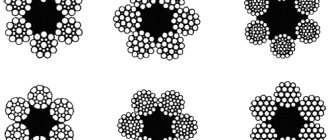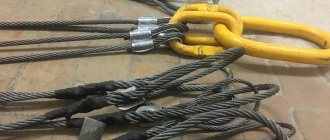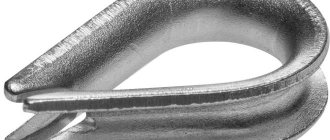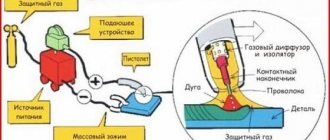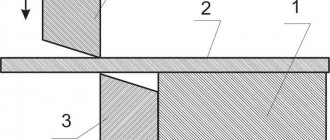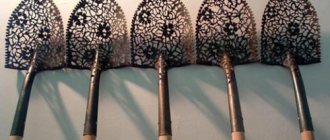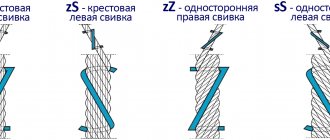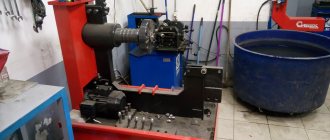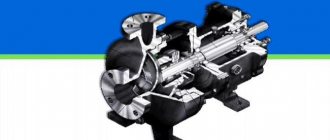The design of steel ropes and types of deformations, the necessary knowledge when working on soft roofs
Rice.
5.1 Double lay steel rope 1 - wire; 2 - strand; 3 - core Table 5.1 Types of strands
| Name | Image |
| Single strand | |
| Three-strand | |
| Five-strand (1 - wire, 2 - strand, 3 - core) | |
| Six-strand | |
| Eight-strand | |
| Eighteen-strand | |
| Closed design with two layers of wedge wire, one layer of Z-wire and TK type core |
The ropes vary in design
Single lay (spiral) - consisting of one, two or three layers of wire twisted into concentric spirals (Fig. 5.2)
Rice. 5.2 Single lay (spiral)
Double lay - consisting of six or more strands twisted into one concentric layer (Fig. 5.3).
Fig.5.3 Double lay
Triple lay - consisting of strands twisted in a spiral into one concentric layer (Fig. 5.4).
Rice. 5.4 Triple lay
According to the type of contact of the wires between the layers, ropes are distinguished:
With a point touch (type TK) - the wire lays have different steps along the layers of the strand, and the wires intersect between the layers. This arrangement of elements increases their wear during shear during operation, creates significant contact stresses that contribute to the development of fatigue cracks in the wires, and reduces the coefficient of filling of the rope section with metal.
With linear touch (LK type) - such strands are produced in one technological step, while the constancy of the wire laying pitch in all layers of the strand is maintained. To obtain a linear touch, the diameters of the wire and strand are selected depending on the design of the latter. Thus, in the top layer of rope strands of type LK-0, wires of the same diameter are used in layers, strands of type LK-R have wires of different diameters in the outer layer, and in strands of type /7/S-Z, wires are used that fill the space between wires of different diameters . There is a type of rope with a linear touch of the wire between the layers and having layers in the strands with wires of both different and identical diameters - LK-RO. In three-layer linear touch strands, there are various combinations of the above types of strands. It should be noted that the performance of ropes with linear contact of wires in strands, with the correct choice of rope design, is much higher than the performance of ropes with point contact of wires.
With point-linear touch (type TLK) - strands of point-linear touch are obtained by replacing the central wire in strands of linear touch with a seven-wire strand: in this case, a layer of wires of the same diameter with a point touch is laid on a two-layer strand of type LK. The design of these strands makes it possible to produce them on spinning machines with a relatively small number of bobbins. In addition, TLC strands, with appropriate selection of laying parameters, have increased non-twisting properties;
Based on the core material, ropes are distinguished:
With organic core (OC). Most rope designs use lubricated organic cores of hemp, manila, sisal or cotton yarn as the core at the center of the rope, and sometimes at the center of the strands, to provide the required flexibility and resilience. The use of cores made of asbestos cord and artificial materials (polyethylene, nylon, nylon, etc.) is also allowed.
With a metal core (MC). It is advisable to use a metal core in cases where it is necessary to increase the structural strength of the rope when multilayer winding it on a drum, to reduce the structural elongation of the rope during tension, and also when operating the rope under conditions of elevated temperature. One of the most common designs of this type is a double lay rope made of 6-7 wire strands located around a central seven-wire strand. The metal core can be made of ordinary rope or soft wire with a tensile strength of no more than 900 N/mm2.
According to the combination of laying directions of strands and rope:
One-way lay rope - with the same direction of lay of the wires in the strands and the strands in the rope (Fig. 5.5).
Rice. 5.5 Single lay rope
Cross lay rope - with the opposite direction of lay of the strands and the rope (Fig. 5.6).
Strands in ropes (LK strand, TK strand)
Externally, a cross lay rope differs in that the wires on its surface are located parallel to the axis of the rope. The wires of a one-way lay rope are located at an angle to its axis.
One-way laid ropes are less rigid, but are prone to unwinding. In crane mechanisms, as well as for the manufacture of slings, they are used.
cross lay nuts, more rigid, but not prone to unwinding under load. Non-unwinding ropes twisted from pre-deformed wires, which will be described below.
According to the laying method, ropes are divided:
Unwinding - the wires are not freed from internal stresses that arise during the process of twisting wires into strands and strands into a rope. Strands, strands and wires in this case do not retain their position in the rope after removing the bandages from its ends;
Non-untwisting (N) - when laying wires into a strand and strands into a rope, internal stresses are removed by straightening and preliminary deformation in such a way that after removing the dressings from the end of the rope, the strands and wires retain their given position. Non-unwinding ropes have a number of advantages compared to unwinding ones: somewhat greater flexibility and a more uniform distribution of tensile forces on the strands and wires, increased resistance to fatigue stress, and no tendency to disrupt straightness when unfolding.
According to the degree of twist, ropes are divided:
Rotating;
Low-rotating (MK). These ropes should be distinguished from non-unwinding ones. In low-twist ropes, thanks to the selection of laying directions of individual layers of wires (in spiral ropes) or strands (in multi-layer double lay ropes), rotation of the rope around its axis is eliminated when the load is freely suspended. A low-twist rope can be made either non-unwinding or unwinding. A prerequisite for the manufacture of low-twisting ropes is the arrangement of the strands in two or three concentric layers with the opposite direction of lay of each concentric row of strands. In this case, the rotational moments of all strands of the rope are balanced, which prevents the overall rotation of the rope around its axis.
Additional materials:
Symbol of steel rope and signs of deformation of steel ropes
Nylon and vegetable rope
Lifting mechanisms for work on soft roofs
Catalog of waterproofing roofing materials from the TechnoNIKOL company
Catalog of roofing fused materials from the manufacturer JSC “Orgkrovlya”
What determines the variety of metal cables?
There are several characteristics by which cables are distinguished: cross-sectional shape and coating.
- A metal cable consists of a weave of steel strands or a more complex structure where the intertwined strands are twisted around a core. Thus, greater flexibility and strength of the rigging device is achieved.
- If the number of strands is 42 or more, the weave occurs around the core. There are metal core (SE) and organic core (FE), which. The presence of a core is necessary to support the steel strands of the cable, which reduces the transverse deformation of the product and radial loads.
- To increase corrosion resistance, the cable is enclosed in a polyvinyl chloride braid or galvanized: galvanic or hot. The latter option is designed for harsh aggressive operating conditions. Black metal cables are not coated with a layer of zinc, but are subject to special treatment.
- The standard size of the cable is characterized by the cross-sectional thickness of the product - from 1 mm to 30 mm
- Under certain operating conditions, it is possible to produce strands from stainless or high-strength steel
Galvanized cables made according to the DIN standard are classified as commercial rigging. They are used everywhere to lift and move loads within the workload for which they are designed. Black cables are manufactured in accordance with GOST and are a lifting device. To ensure sufficient strength, steel cables are processed. The conditions and loads of their use significantly exceed the requirements for galvanized cables.
If we imagine a cable in cross-section, we will see that it consists of six or more steel strands that are firmly intertwined. Cables, depending on strength and wear resistance, can consist of different numbers of steel wires:
- cable made of 42 wires - low-flexibility (DIN 3055);
- cable made of 72 wires – flexible (DIN 3060);
- cable made of 144 wires - refers to high-flexibility fasteners (DIN 3066).
This is interesting: Fiberglass reinforcement: reviews from experts, application experience
Application depending on type
The strength, physical and mechanical characteristics of a steel cable and the area of use largely depend on its design and type.
Metal-polymer cables are used for tying cargo, laying overhead communication lines and installation work. Traveling ropes GOST 16853-88 have found application in the gas and oil industry during drilling. LK-O have excellent wear resistance, which is why they are used in most lifting mechanisms. LK-R are resistant to temperature changes, high humidity, and precipitation, which makes them possible to use in almost any environmental conditions. With the help of special towing ropes, it is possible to pull passenger cars, road trains and huge trucks weighing more than 40 tons.
Codes for various rope lubrication options
| Lubrication code | Organic core | Metal core | Strands of rope | Rope | |
| strands | generally | ||||
| S(A) | without lubrication | without lubrication | without lubrication | without lubrication | without lubrication |
| JSC | greased | blurred | without lubrication | without lubrication | without lubrication |
| A1 | greased | blurred | without lubrication | blurred | without lubrication |
| A2 | greased | blurred | greased | blurred | greased |
| A3 | greased | blurred | without lubrication | without lubrication | greased |
| A4 | without lubrication | without lubrication | greased | blurred | without lubrication |
| A5 | without lubrication | without lubrication | greased | blurred | greased |
| A6 | without lubrication | without lubrication | greased | without lubrication | greased |
Advantages of metal cable
Metal cable is very popular in the construction industry because it has a number of advantages over other fastenings, namely:
- very durable;
- does not stretch or stretch when attached to a building structure;
- easy to use;
- its price is quite low;
- the service life of the cable is very long, so it is possible to sell it even used;
- very convenient to use where there is a possibility of high temperature changes, since it is not sensitive to their effects and does not lend itself to deformation at high or, conversely, low temperatures;
- is not in danger when winding along the ground;
- The weave of the torso wires is so strong that it never breaks during use.
Additional Information
Metal-polymer cables are also produced, in which the wire can be additionally galvanized, due to which the product becomes more resistant to corrosion. There is also a simpler way to protect against corrosion: coating with special lubricants or adding an additional layer of galvanized wire to the structure.
The modern market offers cables whose surface is protected by a material that can withstand combustion and temperature changes.
Purpose of the product
Most often, the product is used for towing, rigging and lifting operations. Durable and flexible, the cable is certainly part of the equipment of excavators, cranes, and drilling rigs. It is also used in the mechanisms for raising and lowering freight and passenger elevators and for concrete reinforcement. Cables are most widely used in lifting operations: the flexibility and high strength of the products allows them to be made into lifting devices that can withstand severe mechanical loads.
Taking into account the complexity of work involving the use of steel cables, the choice of products should be approached with all responsibility. The modern market presents many types of steel ropes and cables, so an ignorant person may get confused because of all this variety. Therefore, in case of difficulties, it is better to seek advice from a professional who will help you choose a product for specific tasks.
Strict performance requirements are imposed on both metal cables and the additional elements with which they are used. Before operation, such products are subjected to various tests and inspections and, if successfully passed, receive certificates and permits allowing use for their intended purpose.
Main settings
The main parameters by which cables are selected are as follows:
- Strength;
- Flexibility;
- Load capacity;
- Tension limits.
To increase resistance to aggressive environments where the cables will be used, in some cases they are subjected to additional processing. Regarding individual areas of use of the product, one of the most significant parameters may be its weight.
Breaking load depending on the characteristics of the cables
The working load is about 25% of the force after which the product is destroyed (partial or complete) and its further use is not ensured by strength. Using the table below, you can select the cable according to its cross-sectional diameter and maximum load.
| Cable diameter, mm | rope elasticity ⇒ ⇒ ⇒ ⇒ ⇒ | ||||
| DIN 3052 | DIN 3053 | DIN 3055 | DIN 3060 | DIN 3066 | |
| 1×7 | 1×19 | 6×7+FC | 6×19+FC | 6×37+FC | |
| 1 | 0.75 kN | 0.83 kN | |||
| 1,5 | 2.25 kN | ||||
| 2 | 3.01 kN | 3.33 kN | 1.95 kN | ||
| 2,5 | 3.2 kN | ||||
| 3 | 7.71 kN | 7.49 kN | 4.39 kN | ||
| 4 | 13.3 kN | 7.8 kN | |||
| 5 | 12.2 kN | ||||
| 6 | 17.5 kN | 16.2 kN | |||
| 8 | 31.2 kN | 28.9 kN | |||
| 10 | 48.8 kN | 45.1 kN | 43.4 kN | ||
| 12 | 65 kN | 62.4 kN | |||
| 14 | 88.5 kN | 85 kN | |||
| 16 | 116 kN | 117 kN | |||
| 18 | 146 kN | 141 kN | |||
| 20 | 181 kN | 173 kN | |||
| 22 | 210 kN | ||||
| 24 | 250 kN | ||||
| 26 | 293 kN | ||||
| 28 | 340 kN | ||||
| 30 | 390 kN | ||||
This is interesting: Anchor bolt with nut: parameters, installation, GOST
